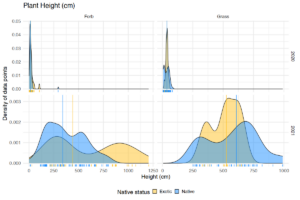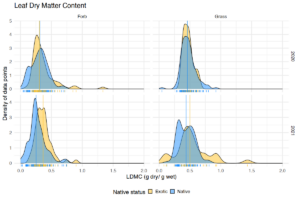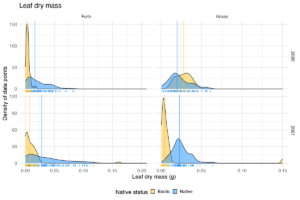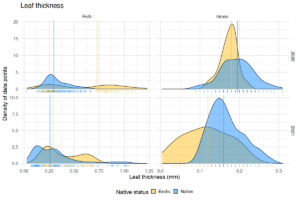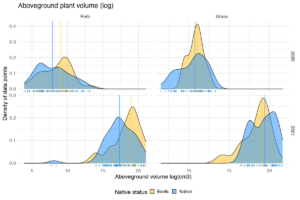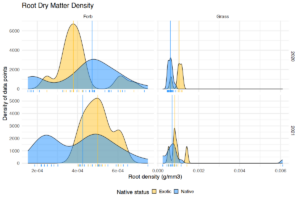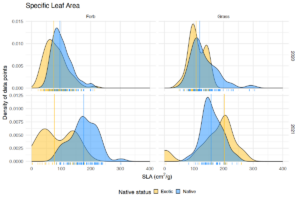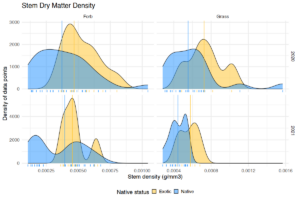Final report for SW19-904
Project Information
Intensifying drought and increasing plant invasions create substantial challenges for ranchers and land managers to balance profitable cattle production and healthy ecosystems on western grasslands. Producer groups across the southwest note the urgent need for financially and ecologically viable approaches to address this challenge by maintaining stable forage production while restoring multiple essential ecosystem functions. Seeding native and non-native forage species based on traits that confer resilience to drying conditions and are also associated with these positive ecosystem functions may provide utility for allowing producers to achieve multiple management goals in the face of changing environmental conditions.
We identified eight management goals (forage production, invasion resistance, drought resilience, carbon sequestration, soil fertility, erosion control, native biodiversity, and pollinator habitat) that producers noted as priorities, based on recent surveys across California and Arizona. Our proposed study is evaluating how plants with specific traits can provide ecosystem services to meet those management goals. We are performing this evaluation through on-ranch experiments in both central California and southern Arizona; regions with extensive productive rangelands that are particularly vulnerable to drought and plant invasion due to the semi-arid climate. Identifying plant trait-ecosystem service relationships will allow ranchers and land managers to select successful reseeding species to meet management goals. We are comparing these relationships between two experimental sites to determine whether a trait-based approach can be applied to regions represented by the climate in central California and southern Arizona. In addition to directly engaging producers throughout the experiment, we are translating project outcomes into science-based recommendations via workshops, field days, and a best-practice manual for ranchers and land managers.
Objective 1: Quantify relationships between plant traits and our ability to meet stakeholder-prescribed management goals over three years.
PI Gornish, and Postdoc Trace Martyn is ensuring timely field sample/data collection and sample processing to obtain metrics of plant traits and ecosystem services at the peak biomass. They are also ensuring proper statistical analysis to determine relationship between plant traits and ecosystem services achieved in the reseeding experiment. Based on our pilot field trials, we expect that seeding perennials will enhance forage production and quality while simultaneously supporting multiple ecosystem services.
Objective 2: Evaluate whether the reseeding approach can achieve the targeted management goals in both experimental sites that represent the climate in California and Arizona.
These two regions differ in precipitation regimes, with central California grasslands dominated by a spring growing season and Arizona grasslands dominated by a summer growing season. Yet both semi-arid regions consist of extensive, productive rangelands that are vulnerable to drought and plant invasion. PI Gornish and Co-PI Leslie Roche have ensured proper selection of plant species suited for each region and proper statistical analysis to compare data acquired from both states over the project period. Producers at both sites were conferred with to choose experimental species based on local management goals. We expect that management goals can be met in both sites when desirable plant species adapted to the precipitation regime in each region are selected.
Objective 3: Develop stakeholder outreach and extension
PI Gornish and co-PIs Roche and Ruyle are developing products that will translate project findings into science-based recommendations for managers throughout the project period. These products include the deployment of one workshop and one field day per year of the project in each state, presentations, and the development of a best practices manual in year 3, which will highlight the identity of plant traits that provide utility for achieving particular management goals.
We are seeking Western SARE funding for the initial start-up phase of the project with immediate deliverables; we intend to leverage this project as a launch pad of a new rangeland restoration program and to seek additional funds to follow the long-term (> 5 years) impacts of reseeded plants to ecosystem services.
May 2019: Project organization meeting – seed mixes discussed, postdoctoral scholar advertisement developed and deployed, key producers to invite to future workshops and field days identified. First advisory group meeting
June – July 2019: Postdoctoral scholar hired; all items for experiment purchased
August – September 2019: Experimental plots deployed
October 2019: Pre-treatment data collected
November 2019: Experimental treatments installed
December 2019 – March 2020: Site maintenance; field day scheduled and organized
April 2020: First field day; second project team meeting
May – October 2020: Data collection. Second advisory committee meeting
November 2020 – January 2021: Data analysis; second field day scheduled and organized
February – March 2021: Presentations of preliminary data deployed; best practices manual draft developed
April 2021: Second field day held; third project team meeting
May – October 2021: Data collection
November 2021 – January 2022: Data analysis completed; final field day scheduled and organized
February – April 2022: Presentations of data deployed; best practices manual draft completed and sent out for review; peer-review articles written
May 2022: Final project team meeting; complete, make available, and publicize best practices manual. Final advisory committee meeting
Cooperators
- (Researcher)
- (Educator)
- - Technical Advisor
- (Researcher)
- - Producer
- - Technical Advisor
- - Producer
- (Researcher)
- - Producer
- (Educator)
- (Educator)
Research
Based on our pilot field trials, we expect that seeding perennials will enhance forage production and quality while simultaneously supporting the supply of multiple ecosystem services. In addition, we, expect that seeding of species with functional traits similar to local invasives will be more effective for control, compared to no seeding or reseeding of species with dissimilar functional traits. We also expect that species with high rooting depth and density will have the greatest capacity for soil carbon sequestration and erosion control.
In Fall of 2019, we deployed one part of the experiment in both California and Arizona. In collaboration with ranchers, we identified 12 native species in California and 18 native species in Arizona to test. The experimental treatments considered of: (1) application type (naked seed, seedballs, none); (2) tilling (absent and present). All treatments were completely crossed with each species in each state in 1meter squared plots, replicated three times. Germination assessments were conducted in February 2020 and establishment was determined in October 2020 in Arizona and March 2021 in California.
Due to the ongoing drought, almost no plants were found in any of our plots in Arizona. To accommodate for this challenge, we deployed a second study. In this study, we are measuring traits of multiple plants already found on site at each location (10 species in each state) and assessing ecosystem services at the local (plant) level to understand relstionships. This new study was deployed in September 2020 in Arizona and January 2021 in California. Data for this new study was collected at both sites (in Nov 2020 in AZ and in April 2021 in CA).
We were able to complete the study in December 2022 and tore down the experimental site as per the request of the producer in January 2023.
We collected functional trait data on 180 plants were collected in Summer 2021 from the Tucson, AZ site. This includes values for plant height, specific leaf area, above and below ground biomass, and root depth and extent. All the above add to the database including data collected in 2021 at the California site and in 2020 at the Arizona site.
We collected soil samples at the AZ site in 2021 for soil nutrient and microbial analyses. We collected at least 4 soil samples associated with each of the species for which we have functional traits. We are currently working on analyses to determine how soil health data correlate with specific species or functional traits.
We are also preparing plant samples collected in AZ from 2020 and 2021 for plant feed analysis. This analysis would provide values for dry matter, protein, fiber, and total digestible nutrients. We will use this data to identify trends with the soil health and functional trait data as well as understanding how forage quality may be impacted by drought by comparing a dry year (2020) and wet year (2021).
In March 2022, we collected seedling data within the experiment testing soil tilling and seedball treatments. We counted emergence for three species that emerged after the winter rains in Arizona (globemallow, Indian wheat, and California poppy). We found that there was no difference in germination rates between any of the treatments for Indian wheat. For globemallow, tilling improved germination rates but there was no difference in germination rates between the seedball and naked seed treatments. For California poppy, we found increased germination rates on tilled soil and decreased germination rates when the poppy seeds were contained within seedballs versus naked seeds.
From our first year of functional trait sampling, we have found that using a handful of traits can accurately describe the landscape. Using statistical analyses, the traits we collected cluster in statistical trait space and we can identify groups of plants based on functional type (e.g. perennial native grasses). Further work will compare trait values and variance across the two different sites (AZ and CA) as well as compare across drought and wet years at AZ.
Our results on the seedling emergence shows that the influence of seedballs and tilling varies in importance between species. We note, however, that for 2 of the 3 species tilling improved seedling germination supporting the idea that increased seed-soil contact can help germination rates.
Research Outcomes
We are still in the process of analyzing the large data set but preliminary findings include:
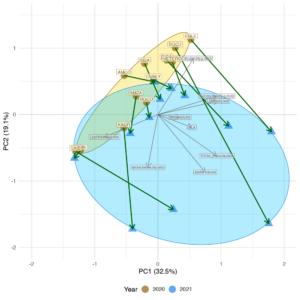
We can see (Fig 1.) that the ellipsoid of trait-space representing 2020 (drought year) is much smaller than the trait-space for 2021. This suggests that the species' traits were limited by resources in 2020 and when released from that limitation, the diversity of traits increases. Another interesting finding is that we found that all perennial grasses were clustered at the top right position of each ellipsoid; this demonstrates that they have similar trait values. It is also interesting that ERLE (an exotic perennial grass) lies at the edge of the trait-space ellipsoid indicating that it may not be at its optimum within this plant community.
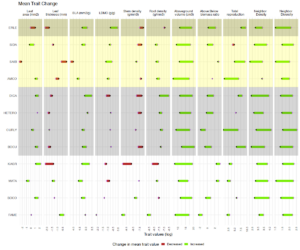
We found (Fig. 2) that increased rain resulted in increases in specific leaf area (SLA) which indicate usage of more resources into leaves for photosynthesis and thinner leaves (Leaf thickness) which is indicative of less resources being allocated for defenses against drought or herbivory. Leaf dry matter content (LDMC) increased for exotic species and decreased for native species. Collectively all of the leaf traits point to increased resource acquisition for rapid biomass production under increased water availability in 2021, especially for the exotic plants and perennial grasses (yellow and grey boxes).
We also saw a decrease in stem density and an increase in root density for all of the perennial grasses. This is correlated with partitioning more resources belowground for root growth and nutrient acquisition as well as faster, less dense growth aboveground. This fast aboveground growth is also represented in increased above ground plant volume (Aboveground volume) and increase above- to below-ground biomass ratio (Above:Below biomass ratio). Compared to the 2020 drought-year, we also saw increased production in flower and seed production (Total reproduction). We also identified that the neighborhood surrounding our sampled plants had an increase in abundance (Neighbor density) and diversity (Neighbor diversity), which is not surprising, given the abundance of resources in 2021.
Overall we found that exotic species and perennial grasses we able to capitalize on available resources and quickly grow. If exotic and native species have similar green-up and reproduction timing (phenology), our results indicated that given available resources, competition between natives and exotics in this area will likely be extremely high. To out-compete exotic species, land managers may consider exploring adding in species that fill different trait and/or phenological niches that might germination or flower earlier/later than established exotics, reducing the potential for competition.
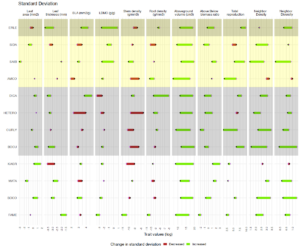
Along with changing mean values (Fig. 2), we found that there was large increase in standard deviation of trait values from 2020 to 2021 (Fig. 3). This suggests that during the wetter year (2021), species were able to fill more trait niche spaces than in a dry year. We do see a decrease in stem density standard deviation for most of the perennial grasses, this might indicate that with adequate resources, there is an optimized mean stem density that the species has for maximum growth and resource usage. Across more species and traits, we do not find a large mis-match; we do not see either a large jump in mean without a large jump in standard deviation or vice-versa. This suggests that there is probably a lot of community filtering for these particular trait values, which is not too surprising for a plant community in a 'harsh' (e.g. arid) environment. Because of this previous filtering, it is important to identify restoration species that can fill in any potential open niches in this trait space.
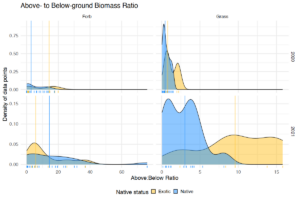
Generally, some traits are fairly conserved across years (Fig. 4) for both grass/forb and native/exotic (like LDMC and Stem Dry Matter Density, an estimate of portioning carbon to above ground structure). Some findings were expected. For example, aboveground plant volume (figures is on a log scale) described how large a plant is (tall and wide); and we found a significant response for all plants. This is entirely unsurprising as more rain tends to mean larger plants. Other findings were less expected. For example, above:belowground drymass was interesting between the years. For forbs, the medians between native and exotic switch place but generally the ratio values are about the same. For grasses, exotic species definitely capitalized on the available water are added a lot more aboveground biomass compared to the native species. For SLA, native forbs in 2021 demonstrated an investment of resources into leaf area to potentially increase the amount of photosynthesis.
We are still working on analyses and will update Western SARE as these become available.
Education and Outreach
Participation Summary:
- We hosted on ranch field tours of the experimental site to local stakeholders just prior to preliminary data collection in February 2020 and September 2022.
- Both PIs have also presented the plan for study to local rancher groups in many both formal and informal settings (this includes at annual meetings of the Altar Valley Conservation Alliance, the AZ section of SRM annual meeting, Cooperative Extension workshops and producer meetings).
- We have hosted three zoom webinars that focus broadly on range seeding using trait based approaches to achieve particular management goals (e.g. in Jan 2021 the theme was soil health (topics included species to use to enhance soil health on rangelands, methods of rangeland compost and biochar application, and methods for assessing success in soil health restoration - attendance included 35 ranchers and 10 non ranchers) in March 2021 the theme was restoration for forage production (topics included native species to seed for forage, methods of weed control in range seeding, and methods to improve range seeding for forage production - attendance included 30 ranchers and 7 non ranchers).
- Four field days in Arizona were hosted (with all COVID safety precautions employed) in August 2020 (4 ranchers attended), March 2021 (9 ranchers attended), February 2022 (11 managers attended), and October 2022 (23 managers attended).
- Presentations of this work have been deployed at the Society for Range Management annual meeting (virtual, Feb 2021) as well as the AZ section of the SRM (August 2020 - 23 non ranchers participated) and multiple county based meetings (Nov 2020 and Jan 2021)
- Multiple plans are in place for more webinars, workshops and very soon we will be creating factsheets and peer reviewed manuscripts. We have found that ranchers adapted very well to webinars, although they all noted that they prefer in person workshops.
We have hosted many on site field days and workshops, bringing information about the project and Western SARE to well over 100 managers in the region. We are currently working on a large manuscript that coalesces all the data. In addition to this peer reviewed publication (submission expected for September 2023), we will create a series of factsheets based on our outcomes to distribute to rancher groups, NRCS offices, county offices and Cooperative Extension in both states.
Education and Outreach Outcomes
As noted previously in this report, the full data analysis is being conducted right now so our recommendations are incomplete. However, we have found that ranchers VERY STRONGLY preferred field visits compared to online workshops or even in person workshops. Ranchers scored field days 42% higher than in person workshops.
- Range management
- Drought resilience
- Ecological restoration
Range management
Drought resilience
Ecological restoration
